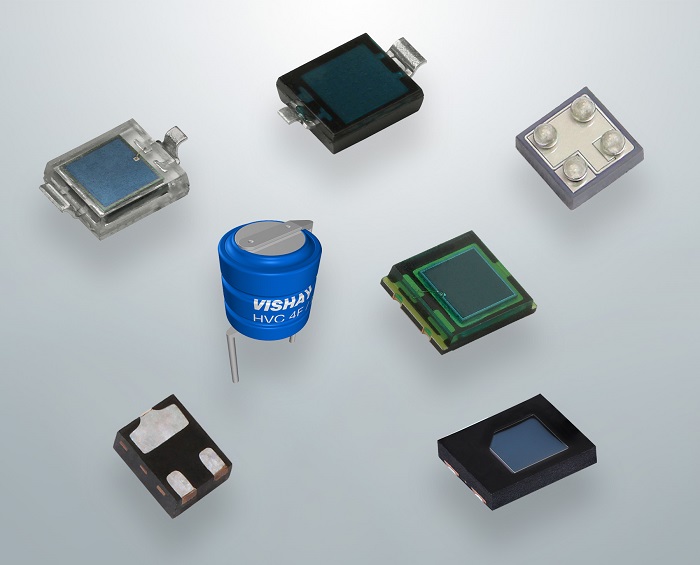Vishay is setting new standards in the world of IoT. This is achieved by photovoltaic energy harvesting, among other factors, in conjunction with a hybrid supercapacitor. Energy harvesting is the derivation of small amounts of energy from energy sources in the surroundings, such as light, heat, vibration, or other differential quantities. The main problems in this area are the most effective harvesting, efficient transformation to a usable voltage level, and lossless storage. Storage capacitors with minimum leakage current are key components here. ENYCAP™ capacitor technology provides good properties to satisfy the demands in this area. It possesses small size, high energy density, low leakage current, and more than 90 % of the rated capacitance, even after 35,000 deep discharge cycles. With these types of energy sources from the surroundings, combined with the correct charging technology, sensors are completely self-sustaining and can be used for considerably longer than the 10 years intended for IoT applications.
 The product range extends from 1.4 V to 8.4 V and 4 F to 90 F.
The product range extends from 1.4 V to 8.4 V and 4 F to 90 F.
The goal of > 10 years of usability, as it was aspired to years ago in the IoT world, can only be achieved if all components used are optimized in nano-ampere design and operate efficiently with minimum losses.
In addition to the 7.5 mm² silicon photocell with 13 % efficiency, this also includes very well isolated MOSFETs connected back to back that prevent the discharge of the ENYCAP™ during periods of darkness. A 40 V diode in the VSKY series from Vishay (for example, VSKY02400603) can perform well in this application, typically offering low forward voltage of 0.475 V at rated current and low leakage current of 0.8 µA at 20 V reverse voltage. However, only active back to back isolation using p-channel MOSFETs, for example, the MicroFoot® (BGA) Si8819EDB or the PowerPAK® 0806 SiUD403ED, achieves typical reverse leakage currents of 10 nA.
However, even the best disconnector switch does not provide a benefit if the self-discharge of the storage capacitor is too high. One particular focus of the development effort of the ENYCAP™ was to reduce the self-discharge such that, even after three months without a load and without a charging current, more than 80 % of the energy charge in the capacitor is still available. In this way, a lengthy period of time can be spanned quite easily with only a little generated (harvested) energy. Conversely, enough energy can be made available to the sensor and the radio module if both circuits must measure or transmit often, for example, for radio messages into the 5G or ISM radio alarm band.
Industry Is Banking on ISM Radio + 5G
Many industrial applications, for example, IIoT, M2M or intralogistics, or other network systems, are banking precisely on this use case. Whether it is a status message from a Euro pallet or the monitoring of some goods with regard to motion or a certain process state, the chief factor is frequently the lowest power sleep mode until an alarm state actually occurs. This might be, for example, incorrect handling, such as dropping the goods or unloading them roughly. Also, the active motion of goods or assets that should not normally be moved would be stored as an error in the sensor or output as a message by radio.
The important point is that precisely then, and this may be the case only after months or years, there is still enough energy to execute the scheduled activity. Aging effects or drift must not impair the function.
ENYCAP™ (a Hybrid With Benefits From Both Worlds)
The energy density of the ENYCAP™, at 50 Wh/kg, is considerably greater than the maximum value of other supercapacitors.
In addition, the voltage of an ENYCAP™ cell has been designed so that connecting individual cells (a multiple of 1.4 V) in series is within the voltage ranges of 1.2 V – 1.5 V or 2.4 V – 3 V. These are the typical voltages of rechargeable batteries or primary cells. With three cells connected in series, this becomes a perfect drop-in replacement for lithium ion cells because this yields exactly 4.2 V – 4.35 V. This version can also be charged with a typical lithium charging IC, a factor that considerably reduces the hurdle for new developments. There are packages available in the button cell replacement sizes of 4.8 mm diameter (comparable to SR412SW, RB414, or ML414 cells), 12.5 mm diameter (comparable to SR44 or CR1225), up to the most powerful oval versions with a diameter of 25 mm – 35 mm. These diameters correspond to capacitances of 4 F, 15 F, and 90 F and absolute energy values of 4.1 Ws up to 115 Ws per 1.4 V cell. Converting into mAh yields ~1.1 mAh to ~30 mAh.
The internal resistance (ESR) of the ENYCAP™ was intensively tested for use in radio applications. The voltage drop across the capacitor is proportional to the internal resistance and the current, for example, with 2.5W internal resistance per 1.4 V cell for the 15 F ENYCAP™ or 7.5 W for the 4 F version.
BLOCK DIAGRAMM
Even the 4F – 4.2 V version, specified at a conservative 22.5 W DC internal resistance in the datasheet, exhibits a voltage drop of only 0.7 V at room temperature and pulse loading and thus, computationally, the internal resistance of 5 W (in the first 100 ms).
The measured currents on the 4.1 V side were 80 mA – 125 mA; the IoT sensor contains a buck converter that converts to the best transceiver voltage. An OOK, FSK, and LORA™ burst was transmitted; after this the circuit waited to receive an “acknowledge” signal.
In order to support further miniaturization aimed at even lower energy consumption (smaller storage capacities), development laboratories are working on SMD versions suitable for reflow soldering with lower residual currents.
Such a Polarized Aluminum Electrical Double Layer Capacitor would have measured on the first samples, e.g. in the 11 x 8 x 2.3 mm design, a capacity of 150mF and leakage currents of 0.5uA after 96 hours at room temperature and full charge.
As a commercially readily available solution, a combination of a PV cell and the ENYCAP™ has been in practical operation successfully for over a year. The boost charging circuit is based on a joint venture with the development partner e-peas. Their chip, the AEM10941, adapted for energy harvesting applications, was tested in the system. Upgrading the Fraunhofer reference design, the MIOTY Cookie, with these two components, the PV cell and the ENYCAP™, was also kicked off. Unfortunately, this last effort has been delayed due to the coronavirus pandemic.
Discussions with the ASIC design company e-peas and several Fraunhofer Institutes precisely verified that the combination of the PV + ENYCAP™ components solve a known problem in the IIoT world.
 Vishay photodiodes were used to implement the PV circuit. Vishay currently offers 29 different photodetector PV cells that are 7.5 mm in size. The VEMD5080X01 is a low profile, blue-enhanced SMD version sized at 5 mm x 4 mm x 0.9 mm. It is the most efficient photodiode of this type, has an opening angle of 130° and generates about 2 mA at 0.52 V under summer sunshine. This corresponds to an efficiency of about 13.8 %.
Vishay photodiodes were used to implement the PV circuit. Vishay currently offers 29 different photodetector PV cells that are 7.5 mm in size. The VEMD5080X01 is a low profile, blue-enhanced SMD version sized at 5 mm x 4 mm x 0.9 mm. It is the most efficient photodiode of this type, has an opening angle of 130° and generates about 2 mA at 0.52 V under summer sunshine. This corresponds to an efficiency of about 13.8 %.
The times are past where regular battery replacement was included in the maintenance tasks and missed maintenance intervals resulted in malfunctions or even failures in the event of an emergency. The latter was a standard problem for years due to, for example, smart meters requiring more power than simulated because the radio connection was poor or suffering interference and the batteries in the field had to be replaced considerably more often than forecast by the manufacturer.
The times are past where regular battery replacement was included in the maintenance tasks and missed maintenance intervals resulted in malfunctions or even failures in the event of an emergency. The latter was a standard problem for years due to, for example, smart meters requiring more power than simulated because the radio connection was poor or suffering interference and the batteries in the field had to be replaced considerably more often than forecast by the manufacturer.
How Important are Maintenance Costs and Effort?
 Even long before the Deutsche Telekom IoT Guide cited once again in 2019, “Our thousands of devices require long battery lifetime to avoid costly replacement,” it was known that the essential maintenance effort for IoT and metering sensors would primarily be frequent battery replacement.
Even long before the Deutsche Telekom IoT Guide cited once again in 2019, “Our thousands of devices require long battery lifetime to avoid costly replacement,” it was known that the essential maintenance effort for IoT and metering sensors would primarily be frequent battery replacement.
This is precisely where Vishay is offering a genuine problem solution. This is also not to forget the mountain of battery waste that is reduced and does not put additional stress on the environment.
The costs for battery replacement can quickly be calculated using the recurring costs for an hour of labor for an installation engineer. Compared to this, the costs for the upgrade combination of a PV cell and ENYCAP™ are only about 5 % of this and do not require any monitoring effort because of the substantially improved deep discharge stability. Conclusion: install and forget.
The typical environmental effects reduce the long life of the IoT sensors of many competing products. This is primarily due to batteries that cannot be used at 50 °C and above or, according to their specification, must not be used.
Vishay was already thinking along those lines and developed the ENYCAP™ for 85 °C. The newest SMD version is even optimized for high temperatures. This is particularly important for outdoor applications, especially considering the increasing average temperatures and hours of sunshine.
In the 5G era, there will be many new small cells, for example, around streetlights that can receive compatible IoT sensor signals. A pioneer is, for example, Sigfox with its own infrastructure. The new 5G technology uses the existing infrastructure, of course, so that, in this case, every smart home, garden, farming, or monitoring sensor can also transmit directly to a 5G network.
Vishay also successfully participated in the development of the reference design of a smart IoT sensor for outdoor use, namely a soil analysis sensor that transmits directly to the 5G network.
In theory, all radio technologies can be retrofit or upgraded with the PV cell plus deep-cycle ENYCAP™ concept. However, those radio standards that use short burst transmissions are the best choice because the low ESR of the ENYCAP™ capacitors can be used to full advantage in the first milliseconds.
More information:
https://www.vishay.com/landingpage/infographics/iot_batteryless.html









